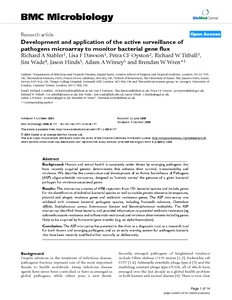Stabler, RA; Dawson, LF; Oyston, PC; Titball, RW; Wade, J; Hinds, J; Witney, AA; Wren, BW
(2008)
Development and application of the active surveillance of pathogens microarray to monitor bacterial gene flux.
BMC MICROBIOLOGY, 8 (177).
ISSN 1471-2180
https://doi.org/10.1186/1471-2180-8-177
SGUL Authors: Hinds, Jason Witney, Adam Austin
![[img]](https://openaccess.sgul.ac.uk/1688/1.hassmallThumbnailVersion/1471-2180-8-177.pdf)  Preview |
|
["document_typename_application/pdf; charset=binary" not defined]
Published Version
Download (852kB)
| Preview
|
Abstract
BACKGROUND: Human and animal health is constantly under threat by emerging pathogens that have recently acquired genetic determinants that enhance their survival, transmissibility and virulence. We describe the construction and development of an Active Surveillance of Pathogens (ASP) oligonucleotide microarray, designed to 'actively survey' the genome of a given bacterial pathogen for virulence-associated genes.
RESULTS: The microarray consists of 4958 reporters from 151 bacterial species and include genes for the identification of individual bacterial species as well as mobile genetic elements (transposons, plasmid and phage), virulence genes and antibiotic resistance genes. The ASP microarray was validated with nineteen bacterial pathogens species, including Francisella tularensis, Clostridium difficile, Staphylococcus aureus, Enterococcus faecium and Stenotrophomonas maltophilia. The ASP microarray identified these bacteria, and provided information on potential antibiotic resistance (eg sufamethoxazole resistance and sulfonamide resistance) and virulence determinants including genes likely to be acquired by horizontal gene transfer (e.g. an alpha-haemolysin).
CONCLUSION: The ASP microarray has potential in the clinic as a diagnostic tool, as a research tool for both known and emerging pathogens, and as an early warning system for pathogenic bacteria that have been recently modified either naturally or deliberately.
| Item Type: |
Article
|
| Additional Information: |
PubMed ID: 18844996
© 2008 Stabler et al; licensee BioMed Central Ltd.
This is an Open Access article distributed under the terms of the Creative Commons Attribution License (http://creativecommons.org/licenses/by/2.0), which permits unrestricted use, distribution, and reproduction in any medium, provided the original work is properly cited. |
| Keywords: |
Bacteria, Bacterial Infections, Bacterial Proteins, DNA, Bacterial, Drug Resistance, Bacterial, Humans, Oligonucleotide Array Sequence Analysis, Virulence, Virulence Factors, Science & Technology, Life Sciences & Biomedicine, Microbiology, YERSINIA-PESTIS, STENOTROPHOMONAS-MALTOPHILIA, MULTIDRUG-RESISTANCE, VIBRIO-CHOLERAE, EVOLUTION, PLASMID, GENOME, PCR |
| SGUL Research Institute / Research Centre: |
Academic Structure > Infection and Immunity Research Institute (INII) |
| Journal or Publication Title: |
BMC MICROBIOLOGY |
| ISSN: |
1471-2180 |
| Related URLs: |
|
| Dates: |
| Date | Event |
|---|
| 9 October 2008 | Published |
|
| Web of Science ID: |
WOS:000262256400001 |
  |
Download EPMC Full text (PDF)
|
 |
Download EPMC Full text (HTML)
|
| URI: |
https://openaccess.sgul.ac.uk/id/eprint/1688 |
| Publisher's version: |
https://doi.org/10.1186/1471-2180-8-177 |
Available Versions of this Item
-
Development and application of the active surveillance of pathogens microarray to monitor bacterial gene flux. (deposited 01 May 2012 23:48)
[Currently Displayed]
Statistics
Item downloaded times since 01 May 2012.
Actions (login required)
 |
Edit Item |




